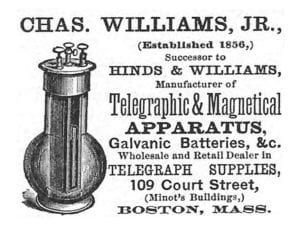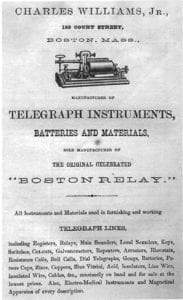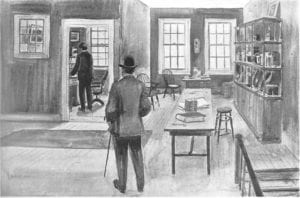The Charles Williams Jr House - One Arlington Street Somerville MA - The Site of the World’s First Home Telephone
“OLD NUMBER ONE AND THE FIRST CENTRAL” – A NEWSPAPER INTERVIEW WITH CHARLES WILLIAMS JR. circa unknown
THE FIRST BELL ‘PHONE – A Somerville Man Tells Why and How It Came to Be Made. – A Wonderful Fifty Years by ET Holmes.
“This is the first Bell Telephone ever made,” said Charles Williams Jr. of Somerville to a reporter the other day. “Every telephone made bears its number, but this is old No. 1.” It was a box of black walnut, and looked like the cover of a sewing machine, but was somewhat smaller. There was no receiver hanging on its back, no crank to turn, no bell to ring—nothing but this box that lay flat on the table.
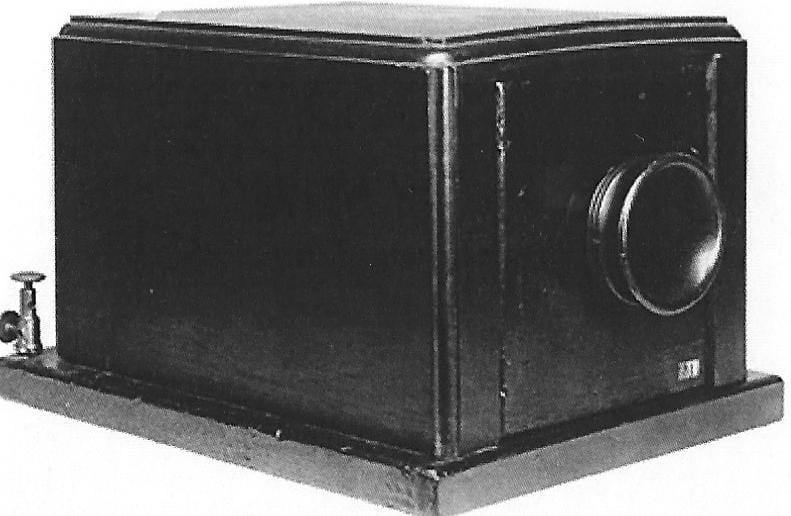
“Bell came to my shop to do his experimental work,” said Mr. Williams, who was at one time in the electrical apparatus business at 109 Court Street in this city. “After he made the phone I strung a wire from my shop out to this house, about three miles, and took this telephone out here. We had another in the shop and when he was ready to call the attention of someone at this end he tapped on the diaphragm with a lead pencil. This was the first way of signaling. It lay on a shelf put up against the wall at such a height that I could speak into it as I sat in a chair facing it.
“Not long afterward we ran a wire up to Music Hall in Boston and gave a public exhibition. We had a cornet player and a quartet here, who played standing before a funnel shaped arrangement that gathered the sound into the telephone. Bell was in Music Hall. He opened with a lecture on the telephone, and then tapped on the diaphragm of the instrument. There was a big audience, but it was so still you could have heard a pin drop. The cornetist in Somerville played “Hold the Fort,” or something of that sort, and everyone in Music Hall heard it. And the cornetist in Somerville heard the applause. Questions were asked and answered over the telephone and the quartet sang and the cornet was played till everyone was satisfied.
“I made all of Bell’s telephones for a long time. Almost every batch we turned out was an improvement over the preceding ones; that is, they were smaller and handier. Then we made a hand telephone that looked something like the present receiver, only it was of wood. You spoke into it and then held it to your ear for an answer. Some people wanted two – one for each hand. Others had both a hand telephone and a box telephone. Afterwards came the Blake transmitter, the magneto-bell and the other devices that make up the telephones of to-day.
“The first telephones we put in were on private lines running from business offices to factories. The first person to have a telephone put in was Frank Downer, banker of 28 State Street, who connected his office with his home on Winter Hill here in Somerville.
“There was no such thing as a ‘central’ then; and E.T. Holmes, who was in the burglar alarm business, and who had wire to several banks, conceived the idea of connecting them up by something like a telegraph switchboard, so that one bank might speak with another. That was the first ‘central.”
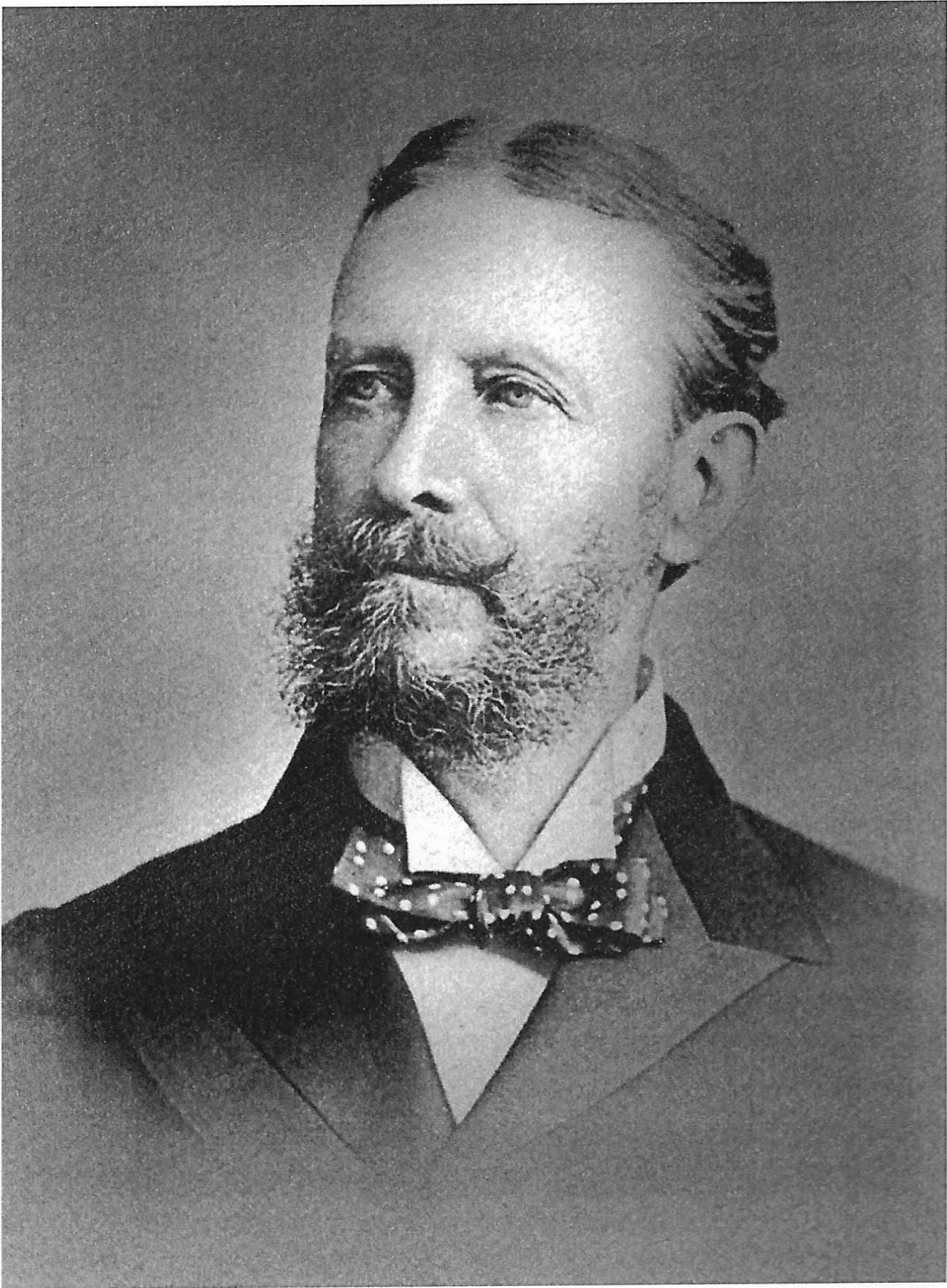
Charles Williams Jr was born on March 2ND, 1830, in Middlesex Village, which was part of Chelmsford and in 1854 was annexed to Lowell
If there were a map showing naturally occurring synergies of proximity, Lowell would be a major nexus point for telephony.
Lowell native Charles Glidden is known as an American telephone pioneer and Lowell’s Dr. Moses Greely Parker is credited with inventing the telephone number directory system. There is another well-known telephone pioneer, Charles Williams Jr, who may have actually been born in the Middlesex Village area of Lowell. I say ‘may have’ because to the best of my knowledge, his birth certificate has not been found.
In 19TH century Massachusetts, new towns were being created by subdividing existing ones. When Charles Williams Jr was born on March 2ND, 1830, Middlesex Village was part of Chelmsford and in 1854 was annexed to Lowell.
Dick Howe, Register of Deeds, provided a preponderance of evidence showing Charles Williams Jr was born in Chelmsford. Passports, membership cards, marriage records, business ownership documents, all refer to Chelmsford as Williams’ birthplace. His death certificate however, states his birthplace was Clermont, NH. As Dick described, “Since he could not have been the provider of that information, it seems clear that whenever he had to identify his place of birth, it was Chelmsford”.
In 1832, Williams’ father, Charles Williams Sr., moved his family to Claremont, NH. In 1846 he moved his family once again to Somerville, MA. Charles Williams Jr was then 16 years old and continued to live in Somerville until his death in 1908.
Because Charles Williams Jr was the manufacturer of the World’s first telephones, was born within a geographical area (now Lowell) which is also home to Massachusetts’ first telephone exchange – the Lowell Telephone Dispatch Co., and the birthplace of the world’s first telephone numbers, I believe that Lowell is a naturally occurring telephone synergy nexus. – Vincent J. Valentine
Background on the First Phones Ever Made
Early in 1877, Thomas Watson gave Charles Williams Jr the first production order of 25 box and 50 hand telephones. Up until this time, Watson had built all of Bell’s phones. On April 4, the first private phone line for practical use was installed between the Williams shop and his home in Somerville. Bell said “I went into his office this afternoon, and found him (Williams) talking to his wife by telephone”. The reported success in the press stirred public interest. Inquiries and orders started to pour in and within a month a leasing plan became practice.
The first customer was a friend of Williams’, Roswell C. Downer. On May 1, 1877, Downer rented two phones that were put on a private line between his State St. office and Downer’s home in Somerville.
By August 1, 1877, 778 phones were in operation without failure. Williams was manufacturing phones at the rate of 25 a day. That month, Williams promised to increase his production from 25 to 50 daily, although he was incurring significant production expenses. The Bell Company, short of capital, relied heavily on the credit extended by Williams.
The manufacturing arrangement between the patent holders and Williams had been informal to this point. A formal agreement was not drawn up until August 1, 1878 giving Williams exclusive rights of manufacture. It consisted of a three page hand written contract. The Bell Telephone Company agreed to purchase all their telephones from Williams, paying him $1.60 for each hand telephone, and $2.45 for each box telephone. Each was subject to inspection by the company’s superintendent, Watson. Williams numbered the instruments in series, the leases were closely monitored, and Watson personally shipped all the instruments.
